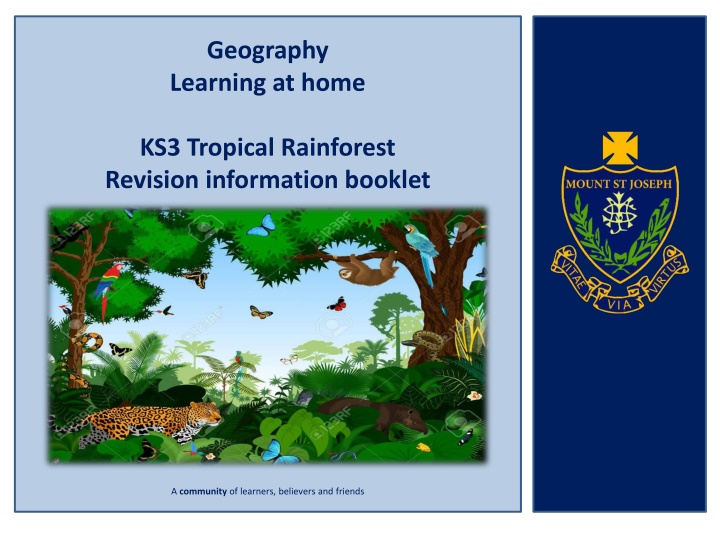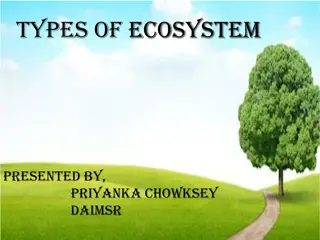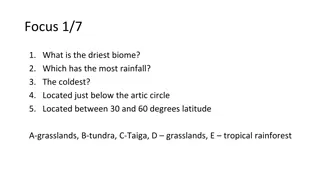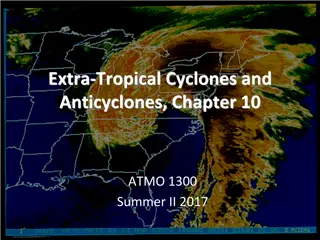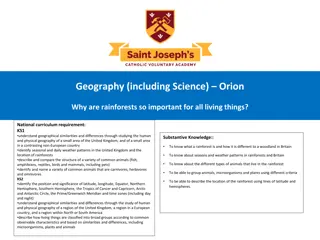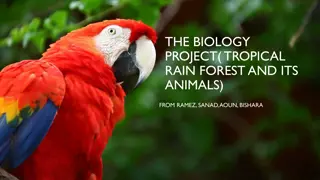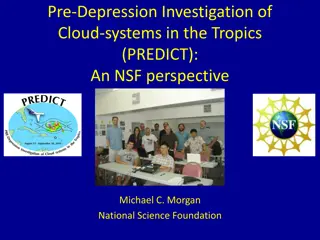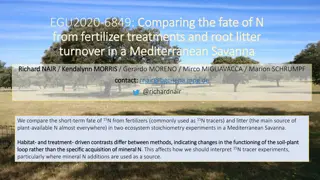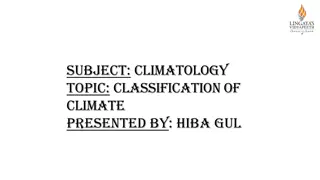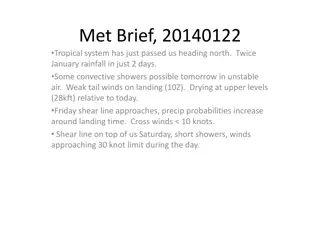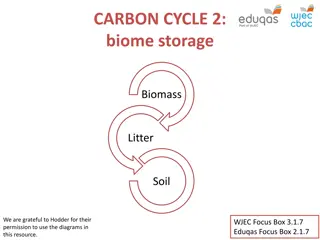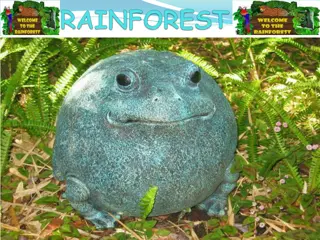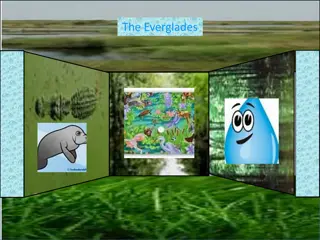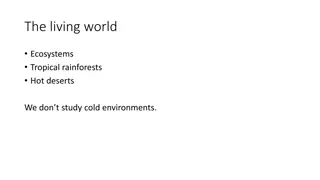Exploring the Rich Ecosystem of Tropical Rainforests
Tropical rainforests, covering 6% of Earth's surface, teem with a diverse array of plant and animal species. With high humidity and abundant rainfall, these ecosystems support complex food webs and serve as crucial global carbon sinks. Learn about their structure, biodiversity, and the importance of conservation in this informative booklet.
Download Presentation

Please find below an Image/Link to download the presentation.
The content on the website is provided AS IS for your information and personal use only. It may not be sold, licensed, or shared on other websites without obtaining consent from the author.If you encounter any issues during the download, it is possible that the publisher has removed the file from their server.
You are allowed to download the files provided on this website for personal or commercial use, subject to the condition that they are used lawfully. All files are the property of their respective owners.
The content on the website is provided AS IS for your information and personal use only. It may not be sold, licensed, or shared on other websites without obtaining consent from the author.
E N D
Presentation Transcript
Geography Learning at home KS3 Tropical Rainforest Revision information booklet A community of learners, believers and friends
Tropical rainforest study Glossary Ecosystem A community of plants and animals Humidity amount of moisture in the air. Micro-organisms A very small living thing Decay Gradually destroyed by natural processes. Adapted Become adjusted to new conditions. Global carbon sink - ability to absorb carbon dioxide from the atmosphere. Biomass Renewable organic materials, such as wood Climate regulator Rainforests act as a way of controlling and maintaining climate Exploitation - the action of making use of and benefiting from resources. Hectare A metric unit of land Food web A complex hierarchy of plants and animals relying on each other for food. Industrial products - goods that are bought and for industry Export - send (goods or services) to another country for sale. Economic - (of a subject) considered in relation to trade, industry, and the creation of wealth. Erosion Wearing away of material Sustainability meets the needs of the present without compromising future needs Agriculture - the science or practice of farming. Pharmaceutical Relating to medicinal drugs, or their preparation, use, or sale. Deforestation The cutting down and removal of forest. Biodiverse - (of a habitat or region) having a high level of biodiversity. Mining - the process or industry of obtaining coal or other minerals from a mine. Environmental - relating to the natural world and the impact of human activity on its condition Urban - relating to or characteristic of a town or city. Rural - relating to or characteristic of the countryside rather than the town.
1. Tropical rainforests Tropical rainforests cover approximately 6% of the earth s surface and are found near the Equator. Although tropical rainforests only cover a relatively small proportion of the earth s surface they support the largest concentration of plant and animal species on the earth. They are generally defined as hot and wet with no real seasonal temperature differences and high annual rainfall. There are variations in the pattern of rainfall across the year but a common characteristic is the high level of humidity which provides ideal conditions for the growth of micro-organisms, an important part of the rainforest ecosystem. The hot, moist conditions create ideal growing conditions so plants can grow quickly and the high rates of decay return minerals to the soil. These minerals are rapidly absorbed by the plants or washed out by the rainfall, so soils are often poor. Most of the energy is stored in the plants and many have adapted to live successfully within the rainforest. It is thought that rainforests have the highest biomass od any ecosystem and contain over 60% of the world s biodiversity, being home to over 15 million different species of plants and animals, including over half the world's flowering plants. The vast range of plant life creates creates the ideal environment for animals to thrive. In the Amazon rainforest it is estimated that on average one hectare of land contains 1500 species of fish, 2000 bird species and over 30,000 species of insect. All of the plant and animal life forms a complex food web, depending on each other to survive.
2. The structure of the rainforest Emergent: A small number of trees break through the general level of the forest, reaching heights of over 30 metres. Canopy: Continuous, dense tree cover protects the ground from heavy rainfall and reduces the amount of light to areas below. Ground layer: Largely made up of decomposed material broken down by the hot, humid conditions. This level consists of scattered plants and fungi, used by insects as a source of food. Under canopy / understorey Woody plants and shrubs grow in the humid, calm conditions with limited sunlight.
3. The importance of the tropical rainforests Tropical rainforests are both a local and global resource. They are coming under increasing pressure as countries see the exploitation of rainforest resources as a way of earning money in order to improve living conditions in some of the poorest parts of the world. Consequently, these is often a conflict with people who feel that the rainforest should be conserved for future generations. Over 50 million years of plant and animal species evolution has created a huge diversity of species. It is estimated that over 10 species are being lost every day due to rainforest destruction. They act as a global carbon sink and a climate regulator, and also help to reduce local risks of erosion and flooding. They provide a wide range of local foods and industrial products, including fibres, resins, dyes and rubber. They are home to over a thousand indigenous tribes which depend on the rainforest for their survival. These people have learned to live sustainably within the rainforest over hundred of years. The rainforest is important for worldwide health. It is a pharmaceutical wonderland providing necessary ingredients to lead healthy lives and cure disease. Medicines from rainforest animals: Bat saliva helps prevent heart attacks Leech saliva dissolves blood clots in humans Frog secretions treat infections, mental illnesses and HIV. Medicines from rainforest plants: Vincristine/Vinblastine from Rosy periwinkle, used to treat Leukaemia and Hodgkin s disease Quinine from the Cinchona Tree, used to treat Malaria Novocaine from the Coca plant, used as a local anaesthetic. Cortisone from Wild Yarns, used in birth control pills
4. Deforestation of tropical rainforests Deforestation is a historic problem people have been deforesting the tropic for thousands of years for timber and farming. However, the rate of deforestation has increased, half the of the world s rainforests have been destroyed in the last 100 years. Thirty years ago, a wide belt of rainforest circled the earth, covering much of Latin America, south-east Asia and Africa. Today, it is being rapidly replaced by great swathes of palm oil trees and rubber plantations, land cleared for cattle grazing, soya farming, expanding cities, dams and logging. In 2015, at the Paris Climate, all countries agreed to reduce carbon emissions, and 50 countries who share the world s tropical rainforests promised to crack down on illegal forestry and restore and replant millions of acres of forest by 2030. It is estimated that 50% of the deforestation of tropical rainforests is a result of illegal activities such as logging, mining and agriculture. These activities create few opportunities for local people and bring no benefit to the government, so they add very little to the wellbeing of the population. In addition, illegal deforestation causes huge amounts of environmental destruction because it is unregulated and ignores any environmental laws.
4. Causes of deforestation in the Amazon What is deforestation? Deforestation is the removal of trees because of human actions. Why do humans deforest? What are the causes of deforestation? Logging: The removal of trees for theselling of the timber, normally for furniture. Agriculture: The deforestation of land so it can be used to grow crops such as soya and graze cattle to sell the beef. Minerals: Beneath the tropical rainforest are valuable deposits of minerals such as bauxite, copper and gold. The trees are cleared and the topsoil removed so that the minerals can be mined. Roads: The trees are removed in order to allow roads to be built. The Trans- Amazonian Highway is a major road built in the 1970s which opens the area for other developments such as farms. Hydroelectric Power: Areas of tropical rainforest are flooded when rivers are dammed for HEP schemes. In Brazil there are plans to build with a further 30 of these projects.
5. How can we stop deforestation? Methods that we can do to manage deforestation: Afforestation- by replanting trees the roots will hold the soil together so will store the nutrients, which encourage growth of other crops. Agroforestry- When we plant trees and crops to mimic the layers of the rainforest. These return nutrients to the soil. The larger trees protect the smaller crops from the sun. Ecotourism- Tourists paying to see the rainforest in its natural state which increases awareness and educates people about the importance of the rainforest. Selective logging- Only some trees are deforested. This allows an income from timber logging whilst destroying less of the rainforest. Buffer zones- An area in which development is restricted in an inner core with mixed conservation/development occurring around the outer core. This protects the primary rainforest in the centre whilst allowing some economic gain. Conservation- The way in which we protect and manage our natural resources, using the methods listed above.
6. Road development in the Peruvian Amazon Impacts Positive Impacts Connect major settlements and create opportunities for development in rural areas Will create trade corridors and links with other countries such as Brazil Create new travel opportunities Roads will pass through protected areas to keep environmental damage to a minimum Will help reduce poverty by encouraging the growth of the mining industry Will bring employment Increase export earnings from trade will increase government earning Negative Impacts Puts over a quarter of a million of hectares of rainforest at risk crossing two indigenous reserves and a National Park Building roads will encourage other activities Significant disruption to wildlife habitats and local communities Nearly half a million people directly depend on the forest for their survival Limited benefits for indigenous people Loss of biodiversity Impact on medicinal supplies Alternatives to the road? Ecotourism Selective logging and replanting Conservation and education International agreements Debt reduction Trade agreements Alternative forms of transport
6. Should road building in the Peruvian Amazon continue? The Stakeholders: How will they be affected & is it worth it? Peruvian Government Significant economic benefits believe this will outweigh environmental impacts Open up new trade links with countries such as Brazil Rise in employment leads to more taxes Increase export earnings for the government which will give the government the opportunity to invest in social improvements Increase in tourism- leads to more income Connect major settlements to improve infrastructure Development fulfils a government pledge to cut poverty by 50% by 2021 Significant government investment Local people Provide employment opportunities Improved living conditions such as access to water, sanitation and doctors Improved transport infrastructure Encourage growth of local industry/businesses such as the mining industry Less local people living in poverty Indigenous communities Loss of biodiversity and habitats Limited resources for the half a million people who directly depend on the forest for their survival Destruction to local communities Change way of life Improved living conditions such as access to water, sanitation and doctors (if wanted) Conservation groups Concerns over the impact on indigenous communities Concerns over the loss of biodiversity Amazon Conservation Association has shown that when a new highway is built through the rainforest it encourages a number of other activities resulting in a band of land up to 10 km wide being lost Local businesses Improved infrastructure Multiplier effect Creation of trade corridors and links with other countries such as Brazil Growth of tourism Easier exports
